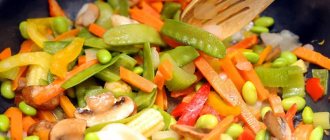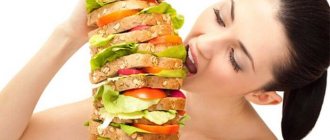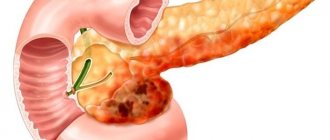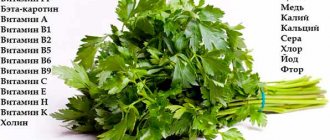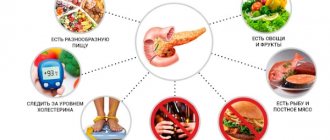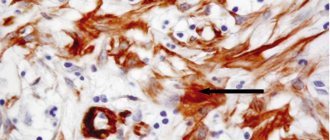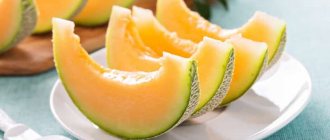author: V. M. Luft, Doctor of Medical Sciences, Professor, Head of the Clinical Nutrition Laboratory of the St. Petersburg Research Institute of Emergency Medicine named after. I. I. Dzhanelidze
In this article we will look at what is recommended by the staff of the clinical nutrition laboratory of the St. Petersburg Research Institute of Emergency Medicine named after. I. I. Dzhanelidze protocol for nutritional support of patients with acute pancreatitis.
Therapeutic nutrition is an integral component of the treatment process, the main task of which is to satisfy the physiological needs of the human body for nutrients and energy, taking into account the mechanisms of disease development, the characteristics of the course of the main and concomitant diseases. Medical nutrition, implemented through the artificial supply of substrate to patients, acquires particular relevance in various emergency conditions, in which nutritional support should be an obligatory component of their basic treatment.
Why do pancreatic diseases occur?
Doctors point to the following causes of pancreatic inflammation :
- snacks, irrationally selected foods, fatty foods;
- overeating, improper diets;
- infections;
- unfavorable lifestyle;
- constant stress;
- bad environment (ecology, unfavorable relationships between people and loved ones).
Any gastrointestinal disease is accompanied by abdominal pain in the abdomen. It is caused by spasms due to excessive activity of the biliary tract and intestines.
Reference. During the period of exacerbation of diseases and with chronic pancreatitis, patients are prescribed a strict diet, which implies a depleted diet and limited intake of important vitamins and microelements into the body. It is necessary to take special supplements, vitamin and mineral complexes. They are considered a good source of essential compounds.
Vitamin therapy
Vitamin therapy can improve the patient’s well-being.
Vitamin therapy can not only eliminate the symptoms of the disease, but also improve the patient’s well-being.
This therapy can be carried out by taking a specific drug or a combination of them. But, in any case, the decision to prescribe a course of vitamin therapy will be made by the attending physician.
The most important factor contributing to the development of vitamin deficiency is impaired absorption of food.
List of useful vitamins for the pancreas
to take vitamins only for therapeutic purposes. The components eliminate inflammation in body tissues and reduce stress on the diseased organ. They not only improve the pancreas , but are also good to take for liver diseases .
The list includes:
- Vitamins of group A. This is retinol - a powerful antioxidant that stimulates the production of leukocytes and interferon, accelerating the regeneration of damaged cells. It has a beneficial effect on pancreatic enzymes , improving its functioning and the entire intestinal tract.
- IN 1. Thiamine is necessary for participation in metabolic processes, since it is an active biochemical catalyst.
- AT 2. Riboflavin fights pancreatic insufficiency by improving its metabolism.
- AT 3. Nicotinic acid activates blood circulation in the capillaries. The pancreas receives new cells to improve tissue trophism.
- AT 6. Pyridoxine increases the elasticity of vascular walls and supports the functioning of the gastrointestinal tract.
- AT 7. The action of biotin is aimed at supporting lipid metabolism, carbohydrate and amino acid metabolism.
- AT 12. Cyanocobalamin creates a normal level of red blood cells in the blood and hemostasis, pancreatic cells .
- C. It is a powerful antioxidant that protects the organ from damage and increases its immunity. of the pancreatic ducts to the effects of viruses and infections improves
- E. Tocopherol is one of the important vitamins that promote high-quality blood circulation and cell restoration. But for effective treatment of pancreatitis , it is necessary to follow the correct daily dosage.
- K. Phylloquinone inhibits the growth of cancer cells, supports the function of the liver and other important organs. Thus, it prevents the development of malignant tumors, inhibiting their differentiation and often causing apoptosis.
Attention! If a person loses a lot of weight, he is prescribed protein preparations based on casein hydrolyzate. They promote protein synthesis in the body. Vitamins A , C and B3 will affect blood clotting, stimulate the production of gastric juice, and increase the normal level of stomach acidity. It is imperative that medications based on the listed components are taken under the supervision of a physician.
Let's start with a definition. Acute pancreatitis (AP)
Acute pancreatitis (AP) is an acute autolytic lesion of the pancreas, manifested by the development of edema of the organ (edematous interstitial pancreatitis) or primary aseptic pancreatic necrosis (destructive or necrotizing pancreatitis) with the subsequent development of both local and systemic inflammatory reactions, as well as various involvement of other regional tissues or distant body systems with a high risk of secondary purulent infection.
Currently, acute pancreatitis represents a very significant social problem. For example, according to data from hospitals in St. Petersburg, OP ranks first in the overall structure of patients with acute surgical diseases of the abdominal organs, reaching 42% of all hospitalized patients. In the general structure of surgical patients admitted to the Research Institute of Emergency Medicine named after. I. I. Dzhanelidze in the period from 2002 to 2006, OP also ranks first and has a steady upward trend. The medical and social significance of AP is determined by the relatively frequent (15–20%) severe course of the disease with the development of life-threatening complications, the need for long-term inpatient expensive treatment of patients, long-term disability, frequent chronicity of the process (up to 60–65%), early disability, as well as the high mortality rate of patients with severe disease (25–30%).
The basis of the clinical and morphological classification of acute pancreatitis is the form of the disease, intra-abdominal and systemic complications, taking into account the prevalence of necrotic lesions of the pancreas and various parts of the retroperitoneal tissue, the phase development of the inflammatory-necrotic process from abacterial to infected.
Forms of the disease
- Edematous (interstitial) pancreatitis.
- Sterile pancreatic necrosis:
- according to the extent of the lesion: limited and widespread;
- by the nature of the lesion: fatty, hemorrhagic, mixed.
- Infected pancreatic necrosis.
Local complications
In the pre-infectious phase:
- Parapancreatic infiltrate (omentobursitis, volumetric fluid formations of retroperitoneal localization).
- Necrotic (aseptic) phlegmon of retroperitoneal tissue (parapancreatic, paracolal, perinephric, pelvic, etc.).
- Peritonitis: enzymatic (abacterial).
- Pseudocyst (sterile).
- Arrosive bleeding (intra-abdominal and in the gastrointestinal tract).
During the infection phase:
- Septic phlegmon of the retroperitoneal tissue: parapancreatic, paracolar, paranephric, pelvic.
- Pancreatogenic abscess (retroperitoneal fatty spaces or abdominal cavity).
- Fibrinous-purulent peritonitis (local, widespread).
- Infected pseudocyst.
- Internal and external pancreatic, gastric and intestinal fistulas.
- Arrosive bleeding (intra-abdominal and in the gastrointestinal tract).
Systemic complications
- Pancreatogenic shock in sterile pancreatic necrosis and its intra-abdominal complications.
- Septic (infectious-toxic) shock in infected pancreatic necrosis and its intra-abdominal complications.
- Multiple organ failure in both sterile and infected pancreatic necrosis and their complications.
As is known, in acute pancreatitis there are certain sequentially developing phases:
Phase I is enzymatic (the first 3–7 days of the disease), which is characterized by the development of acute interstitial inflammation of the pancreas or the formation of pancreatic necrosis of varying severity and prevalence, enzymatic endotoxicosis, and in some patients, multiple organ failure. Based on the severity of clinical and laboratory disorders arising from acute pancreatitis, three clinical variants of its course are distinguished: mild, moderate and severe.
Mild acute pancreatitis is characterized by minimal manifestations of organ dysfunction, the absence of endogenous intoxication, and a rapid positive effect during conservative therapy. The morphological substrate of this clinical form is interstitial (edematous) pancreatitis.
Want more new information on nutrition issues? Subscribe to the informational and practical magazine “Practical Dietetics”!
SUBSCRIBE
Severe acute pancreatitis is manifested by severe endogenous intoxication, exicosis, multiple organ disorders, sometimes pancreatogenic shock, systemic inflammatory response syndrome, respiratory, renal, intestinal failure, the development of coagulopathy and metabolic dysfunction, lack of improvement or a tendency to worsen the patient's condition against the background of complex conservative therapy. The morphological substrate of this clinical form is widespread (large focal or total-subtotal) sterile or infected necrotizing pancreatitis and its complications.
Acute pancreatitis of moderate severity occupies an intermediate position between the forms described above and is characterized by a mildly expressed systemic inflammatory reaction syndrome, respiratory, renal or intestinal failure, moderate endotoxicosis, improvement of the patient's condition against the background of complex conservative therapy with preservation of local symptoms of the disease in the first two days. The morphological substrate of this clinical form is small-focal, moderately widespread necrotizing pancreatitis.
Phase II is reactive (2nd week of the disease), characterized by the body’s reaction to the formed foci of necrosis (both in the pancreas and in the parapancreatic tissue).
Phase III - melting and sequestration (starts from the 3rd week of the disease, can last several months). Sequesters in the pancreas and retroperitoneal tissue begin to form from the 14th day from the onset of the disease. There are two possible options for the course of this phase:
- aseptic melting and sequestration (sterile necrotizing pancreatitis) with the formation of postnecrotic cysts, sometimes fistulas;
- septic melting and sequestration (infected necrotizing pancreatitis) with further development of local and systemic (often sepsis) complications.
The tactics of nutritional support for patients with acute pancreatitis is determined by the type of pathomorphological changes in the pancreas (edematous, necrotizing), the stage of the disease, the severity of pathophysiological disorders and the characteristics of the clinical course of acute pancreatitis, as well as options for their surgical treatment.
The protocol for nutritional support of patients with acute pancreatitis is presented by V. M. Luft, MD, Professor, Head of the Clinical Nutrition Laboratory of the St. Petersburg Research Institute of Emergency Medicine named after. I. I. Dzhanelidze, and researcher at the specified laboratory, Ph.D. A. V. Lapitsky.
NB One of the most important points in intensive therapy of acute pancreatitis in the enzymatic phase of the disease is the creation of functional rest and suppression of exocrine activity of the pancreas. This involves temporarily prohibiting oral intake of fluids and food until signs of systemic “evasion” of pancreatic enzymes are completely eliminated. In this case, normovolemic correction of water-electrolyte balance during this period is carried out parenterally.
It has now been shown that in mild cases of acute pancreatitis (edematous form) and signs of gland destruction according to computed tomography data, fasting prescribed for the first 2–3 days does not affect the course and outcome of the disease and this category of patients does not require active nutritional support.
In cases of acute pancreatitis of moderate severity, and especially severe disease, which occurs with pronounced phenomena of hypermetabolism-hypercatabolism, rapidly progressing protein-energy deficiency, increasing immunosuppression with the addition of various infectious complications, nutritional support, which should begin in the first 24–48 hours, is a mandatory priority component of intensive treatment for this category of patients.
NB Severe acute destructive pancreatitis in more than 90% of patients occurs with symptoms of early developing acute intestinal failure and refers to diseases in which the most important role of opportunistic flora of the gastrointestinal tract has been proven as an additional source of endogenous infection of patients.
With the development of acute intestinal failure, conditions are created for ascending colonization of the proximal parts of the small intestine by opportunistic flora and subsequent uncontrolled translocation of microbes and their toxins into the blood, which is the main source of endogenous (enterogenous) infection of foci of pancreatic necrosis.
Acute intestinal failure syndrome is the “motor” and the main factor in the pathogenesis of multiple organ failure that often occurs in these patients. Quick and effective relief of symptoms of multiple organ failure without resolving acute intestinal failure is impossible.
What foods contain beneficial vitamins?
For gastrointestinal diseases, it is necessary to select the right products, since beneficial components will be supplied through meals . Among them are:
- Broccoli. It is a good antioxidant containing calcium, magnesium, phosphorus and vitamins B and C. Cabbage contains beta-carotene and folic acid. However, broccoli is considered an effective antitumor component and an excellent source of fiber.
- Kiwi. Pancreatic tissue needs potassium, magnesium, phosphorus and vitamin C. Kiwi perfectly nourishes it and also participates in the synthesis of pancreatic juice.
- Millet. Cereals are rich in microelements and B vitamins. They take part in insulin metabolism to combat diabetes mellitus .
- Apples. Improve digestion, include pectins to bind toxic substances.
- White cabbage. Source of folic acid, vitamin D , C and iodine. Provokes the production of enzymes , having a regulating effect on the functionality of the gland.
- Oranges. Help fight internal viruses and infections. They include vitamins A, C, B, and therefore are considered powerful antiseptics. In addition, they contain rubidium, which is responsible for insulin secretion.
- Sea kale. Its action is aimed at improving digestion, as it contains iron, calcium, iodine, and potassium.
- Walnuts. They help normalize the synthesis of pancreatic pancreatic juice due to the content of a large amount of polysaturated acids.
- Natural dark chocolate. Improves the functioning of the gastrointestinal tract , regulates the activity of the gland. Used in its pure form without sugar.
- Onion (onion, feather). Soothes the gland, eliminates pain, gives comfort.
Important! Before consuming these products, you should consult your doctor. Not everyone can take, for example, chocolate or oranges.
General signs of vitamin deficiency
There are several indicators that indicate that a person is developing vitamin deficiency. Timely detection of these symptoms can prevent the development of other diseases or their exacerbation. Signs of vitamin deficiency:
- Lethargy
- Irritation
- It's hard to wake up in the morning
- Forgetfulness
- Dry skin
- Brittle or split ends of hair
- Rash
These are not all the symptoms. After all, a person is an individual, and signs can also be individual.
Groups of vitamins
Vitamins are responsible for normal metabolism and the body's defenses.
Today there are many drugs for vitamin therapy. But each drug belongs to a specific group and performs a specific function.
Group of B vitamins. With pancreatitis, patients develop a deficiency of B vitamins.
Other groups of vitamins
Rose hips contain vitamin C.
In addition to medications and foods containing vitamin B, the body may lack other vitamins. Each vitamin performs its own function and affects the human body.
Vitamin RR. When a patient lacks this vitamin, he feels aversion to food, dry mouth, and the stomach does not produce gastric juice. There may also be constipation or diarrhea.
Vitamin PP, also known as nicotinic acid, is prescribed in the remission stage to normalize the production of gastric juice in pathologies of the digestive system. In addition, nicotinic acid has a vasodilating effect, improves blood circulation and tissue nutrition.
Vitamin A. It is an antioxidant. Responsible for facilitating the process of fat breakdown and has a positive effect on the digestion process due to dysfunction of the organ.
Vitamin A is found in broccoli and liver. If the patient has a vitamin A deficiency, this may affect the eyes. This may manifest itself in deterioration of vision at dusk, and dryness of the mucous membrane of the eye may also appear. With a lack of vitamin A, the immune system weakens and a person may get sick more often.
Vitamin B3 (niacin, nicotinamide, nicotinic acid)
Vitamin B3
(
niacin, nicotinamide, nicotinic acid, vitamin PP
*) is a water-soluble vitamin from the group of B vitamins.
Basic functions and intakes of niacin (vitamin B3)
According to Methodological Recommendations MP 2.3.1.2432-08 “Norms of physiological needs for energy and nutrients for various groups of the population of the Russian Federation”, approved by Rospotrebnadzor on December 18, 2008, vitamin B3 (niacin) as a coenzyme is involved in the redox reactions of energy metabolism .
Insufficient vitamin intake is accompanied by disruption of the normal condition of the skin, gastrointestinal tract and nervous system. The average consumption in different countries is 12-40 mg/day, in the Russian Federation - 13-15 mg/day. Niacin can be synthesized from tryptophan (60 mg of tryptophan produces 1 mg of niacin). The established level of requirement in different countries is 11-25 mg/day. The upper tolerable level of niacin intake is 60 mg/day. The physiological requirement for adults is 20 mg/day. The physiological need for children is from 5 to 20 mg/day. The 2015–2020 Dietary Guidelines for Americans (official publication of the US Department of Health) recommend the following daily intakes of niacin (vitamin B3):
- children under 3 years old - 6 mg
- children from 4 to 8 years old - 8 mg
- children from 9 to 13 years old - 12 mg
- girls and women aged 14 years and older - 14 mg
- boys and men aged 14 years and older - 16 mg
With insufficient intake of vitamin B3 in the body, lethargy, apathy, fatigue, dizziness, insomnia, palpitations, pale and dry skin, and reduced resistance to infections are observed. With a severe deficiency of vitamin B3, pellagra develops - a serious disease affecting the gastrointestinal tract, skin, central and peripheral nervous system.
Nicotinamide is the international nonproprietary name of the drug
In ATC, nicotinamide is included in the “A11 Vitamins” group, the “A11HA Other pure vitamins” subgroup.
Nicotinamide code is A11HA01. Pharmacological group “Vitamins and vitamin-like products”. Nicotinamide is part of the B vitamin group (vitamin B3, or PP). It is a source of niacin, as well as nicotinamide adenine dinucleotide (NAD) and nicotinamide adenine dinucleotide phosphate (NADP), which are coenzymes for many enzymes that catalyze redox reactions. Nicotinamide is involved in the metabolism of carbohydrates, normalizes intestinal motility, and is necessary for the functioning of normal intestinal microflora. Nicotinamide does not cause adverse reactions characteristic of nicotinic acid: it does not cause redness of the skin, tingling or burning sensation, hypotension, dizziness, heart rhythm disturbances, or dyspeptic symptoms. There was no connection between the use of nicotinamide and exacerbation of gastric and duodenal ulcers, or decreased glucose tolerance (Serebrova S.Yu.).
Nicotinic acid is the international nonproprietary name of the drug
In the ATC, nicotinic acid and its derivatives are included in section “C.
Drugs for the treatment of diseases of the cardiovascular system": in group "C04. Peripheral vasodilators" and have the following codes:
C04AC Nicotinic acid and its derivatives C04AC01 Nicotinic acid C04AC02 Nicotinyl alcohol (pyridylcarbinol) C04AC03 Inositol nicotinate C04AC07 Cyclonicate
to group “C10. Lipid-lowering drugs" and have the following codes:
| Nicotinamide |
| Nicotinic acid (niacin) |
C10AD Nicotinic acid and its derivatives C10AD01 Niceritrol C10AD02 Nicotinic acid C10AD03 Nicofuranose C10AD04 Aluminum nicotinate C10AD05 Nikonitic alcohol (pyridylcarbinol) C10AD06 Acipimox C10AD52 Nicotinic acid in combination with other drugs
Nicotinamide and nicotinic acid (niacin) as chemicals
Nicotinamide (eng. nicotinamide
) - amide of nicotinic acid, 3-pyridine carboxamide. White crystalline powder. Easily soluble in water and alcohol. Its structure and action are similar to nicotinic acid. Gross formula: C6H6N2O.
Nicotinic acid
or
niacin
). 3-Pyridinecarboxylic acid. White crystalline powder, odorless, slightly acidic taste. Slightly soluble in cold water (1:70), better in hot water (1:15), slightly soluble in ethanol, very slightly soluble in ether. Gross formula: C6NH5O2.
Indications for use of vitamin B3
| Patient with pellagra (vitaminosis B3) |
Taking vitamin B3 in any form is indicated:
- in the prevention and treatment of pellagra (vitaminosis B3, vitamin deficiency PP)
- slow-healing wounds and ulcers
- gastritis with low acidity
- colitis
Nicotinamide is also recommended for:
- peptic ulcer of the stomach and duodenum (not in the acute stage)
- diabetes mellitus
- atherosclerosis
Nicotinic acid is also indicated for:
- Crohn's disease
- tropical sprue
- spasm of peripheral vessels
- Hartnup's disease
- Raynaud's disease
- migraine
- cerebrovascular disorders
- angina pectoris
- hypercoagulability
- neuritis of the facial nerve
Nicotinic acid (niacin) as a means of preventing heart attack and stroke?
Extended-release niacin (niacin) in men who have had a myocardial infarction increases high-density lipoprotein (HDL) cholesterol levels and reduces lipoprotein (a) concentrations, reducing the risk of recurrent myocardial infarction. Nicotinic acid preparations can be used in patients with low HDL cholesterol values or increased lipoprotein (a) levels, but the benefit of this therapy in reducing the risk of ischemic stroke is not shown (Fonyakin A.V., Geraskina L.A.).
Sources of vitamin B3
Many foods are rich in vitamin B3: yeast, liver, nuts, egg yolk, milk, fish, chicken, meat, legumes, buckwheat, unrefined grains, green vegetables, ground nuts, flaxseed oil.
Vitamin B3 (nicotinamide or nicotinic acid) can be sold as a medicine or dietary supplement in the form of a single drug, it is also included in complex preparations, for example, Enzymtal (fungal amylase + papain + simethicone + activated carbon + nicotinamide), Cytoflavin (inosine + nicotinamide + riboflavin + succinic acid), eye drops Oftan Katahrom (adenosine + nicotinamide + cytochrome C).
Vitamin B3 is part of the vitamin and mineral complexes: Bio-Max, Complivit, Selmevit, Vitrum, Hexavit, Multi-Tabs, Vitamin and mineral complex from A to Zn (“Vitamins for adults”) and many others.
Vitamin B3 is usually included in infant formula (Kozhevnikova E.N.).
Vitamin B3 is synthesized by human intestinal bacteria, in particular Escherichia coli
.
Vitamin B3 (niacin, nicotinamide) has contraindications, side effects and application features; consultation with a specialist is necessary.
* By “vitamin B3” we mean not one substance, but several different substances that are very similar in their biochemical effects on the human body and physiology. Please note that different authors do not have 100% terminological unity. For example, in the articles of Serebrova S.Yu., Kovaleva K.A. and a number of others, the terms “vitamin B3”, “vitamin PP” and “nicotinamide” are used as synonyms. And in the article by Kivaeva I.V. and others, on the one hand, “nicotinic acid” and “vitamin PP” are considered synonyms, and on the other, “niacin” and “vitamin B3”. We do not set out to arbitrate these differences and try to avoid them as far as possible.
Nicotinamide - a means of preventing skin cancer (?)
Non-melanocytic skin cancers, such as basal cell and squamous cell carcinomas, are common cancers caused primarily by ultraviolet radiation.
Nicotinamide has been shown** to have a protective effect against damage caused by ultraviolet healing and also to reduce the incidence of new cases of precancerous photochemically active keratoses. Nitotinamide, when taken orally, is safe and effective in reducing the incidence of new cases of non-melanocytic skin cancer and photoactive keratoses in high-risk patients.** It is emphasized that the trials were conducted specifically with nicotinamide .
and not with nicotinic acid or other similar substances.***
** Andrew C. Chen AC et al. A Phase 3 Randomized Trial of Nicotinamide for Skin-Cancer Chemoprevention. N Engl J Med 2015;373:1618-26 | DOI: 10.1056/NEJMoa1506197. *** Damian DL et al. Nicotinamide for Skin Cancer Chemoprevention / The Melanoma Letter, A Publication of The Skin Cancer Foundation. Vol. 34, Spring 2016.
Nicotinic acid - food supplement
Nicotinic acid, as a food additive, has code E375 and is defined by SanPiN 2.3.2.1293-03 as a color stabilizer. In 2008, it was excluded from the list of permitted food additives in Russia. The reason is a lack of research data. Also, nicotinic acid does not have permission for use as a food additive in Ukraine. Back to section
